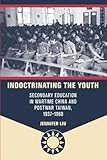Indoctrinating the Youth : Secondary Education in Wartime China and Postwar Taiwan, 1937–1960 / Jennifer Liu.
Material type: TextPublisher: Honolulu : University of Hawaii Press, [2024]Copyright date: 2024Description: 1 online resource (234 p.) : 10 b&w photographsContent type:
TextPublisher: Honolulu : University of Hawaii Press, [2024]Copyright date: 2024Description: 1 online resource (234 p.) : 10 b&w photographsContent type: - 9780824895570
- 9780824896997
- Communist education -- China -- History -- 20th century
- Communist education -- Taiwan -- History -- 20th century
- Education and state -- China -- History -- 20th century
- Education and state -- Taiwan -- History -- 20th century
- Education, Secondary -- China -- History -- 20th century
- Education, Secondary -- Taiwan -- History -- 20th century
- HISTORY / Asia / China
- China Youth Corps
- China education
- China history
- Sino-Japanese war
- chiang kai-shek
- china gmd
- communist education
- communist history
- military communism
- military education
- three people's principles youth corps
- 379.51/0904 23//eng/20230801eng
- online - DeGruyter
| Item type | Current library | Call number | URL | Status | Notes | Barcode | |
|---|---|---|---|---|---|---|---|
 eBook
eBook
|
Biblioteca "Angelicum" Pont. Univ. S.Tommaso d'Aquino Nuvola online | online - DeGruyter (Browse shelf(Opens below)) | Online access | Not for loan (Accesso limitato) | Accesso per gli utenti autorizzati / Access for authorized users | (dgr)9780824896997 |
Frontmatter -- Contents -- Acknowledgments -- Note on Romanization -- Abbreviations -- Introduction -- 1. Te Relocation of Middle Schools during the Sino-Japanese War, 1937–1945 -- 2. Te Tree People’s Principles Youth Corps on the Mainland, 1938–1947 -- 3. Te China Youth Corps in Taiwan, 1952–1960 -- 4. Military Training and Instructors, 1953–1960 -- 5. Civics Textbooks and Curricular Standards, 1937–1960 -- Epilogue -- Notes -- Bibliography -- Index -- About the Author
restricted access online access with authorization star
http://purl.org/coar/access_right/c_16ec
Indoctrinating the Youth examines how the Guomindang (GMD or Nationalists) sought to maintain control of middle-school students and cultivate their political loyalty over the trajectory of the Second Sino-Japanese War, Chinese Civil War, and postwar Taiwan. During the Sino-Japanese War the Nationalists managed middle-school refugee students by merging schools, publishing and distributing updated textbooks, and assisting students as they migrated to the interior with their principals and teachers. In Taiwan, the China Youth Corps (CYC) became a symbol of the regime’s successful establishment. Tracing Nationalist efforts to indoctrinate ideology and martial spirit, Jennifer Liu investigates how GMD leaders Chiang Kai-shek and his son Chiang Ching-kuo tried to build support among young people in their efforts to stabilize Taiwanese society under their rule. By comparing two key youth organizations—the Three People’s Principles Youth Corps in China, and the CYC on Taiwan—Liu uses education as a lens to analyze state-building in modern China. Liu’s careful analysis of the inner workings of GMD youth organizations also illuminates the day-to-day operations of military training in gender-segregated upper-middle schools—including how the government selected instructors and the skills taught to students. According to Liu, mandatory military training contributed to preventing major protest against the government but the policy was not without critics. Intellectuals, parents, and students voiced their dissent at what they perceived as excessive control by a repressive government and a waste of resources interfering with academics. The government-mandated civics curriculum, including government-approved textbooks and standards, reveals the characteristics and duties GMD officials believed modern citizens of the next generation should possess. Through provisions for refugee students, youth organizations, military training, and civics classes, GMD secondary education policy played a critical role in the process of state building in both modern China and Taiwan.Skillfully combining archival work in Nanjing and Taipei, along with oral interviews with former students and CYC administrators, instructors, and members, Liu offers a unique perspective toward a balanced assessment of Nationalist Party rule.
Mode of access: Internet via World Wide Web.
In English.
Description based on online resource; title from PDF title page (publisher's Web site, viewed 20. Nov 2024)


